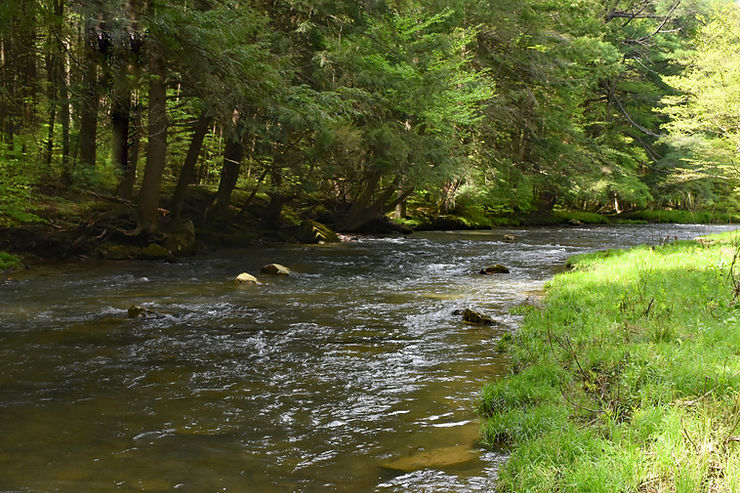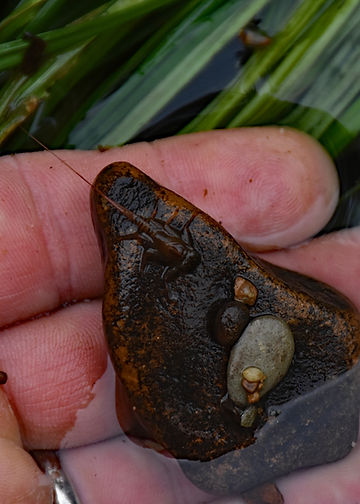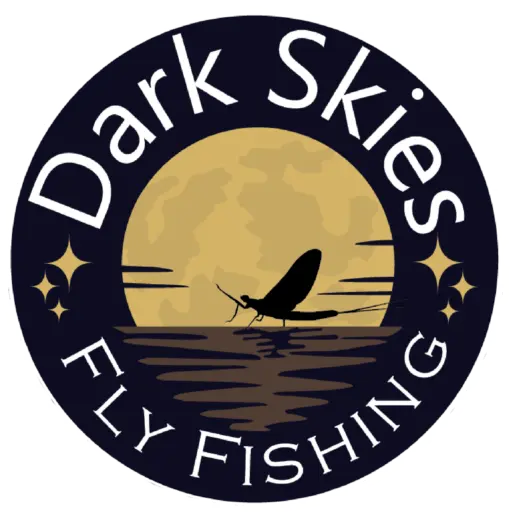East Hickory Creek

If a stream were judged by scenic beauty alone, East Hickory Creek would rank high on anyone’s list. The combination of wilderness setting and solitude make it a pleasant place to visit. Throw in trout stockings by the PA Fish and Boat Commission, good populations of wild and native trout, and abundant mayfly hatches and East Hickory Creek becomes a must-fish for anyone looking to cure their cabin fever.
East Hickory Creek begins in the Hickory Creek Wilderness which is part of the Allegheny National Forest in southern Warren County. It then flows southwest into Forest County for approximately 12 miles before joining the Allegheny River near the town of East Hickory. Most of the stream’s headwaters are remote and only accessible by hiking in. However, if you’re willing to put forth the effort, you can find good fishing for native Brook Trout in the main stem as well as many of its tributaries.

For most of its length, East Hickory Creek flows through dense forest which means that its water is cold and gin clear. Higher flows in early spring make for great fishing, but once those levels start to drop, trout can get skittish making a stealthy approach necessary. However, because the stream originates in such pristine country, the water quality is exceptionally good, and East Hickory Creek is home to a plethora of insects, including one of the best Green Drake hatches I’ve ever seen.
 One of my favorite early season East Hickory Creek hatches, though, is the size 18 Little Black Stonefly. Unlike mayflies, which metamorphose into adults as they emerge through the water column, stoneflies crawl along the stream bottom and climb up onto rocks and logs on shore where they shed their nymphal shucks and become full-fledged adults. Little Black Stoneflies start appearing on East Hickory Creek in mid-March, earning them the nickname “the snowflake hatch,” as they seem to be present on even the coldest early spring days.
One of my favorite early season East Hickory Creek hatches, though, is the size 18 Little Black Stonefly. Unlike mayflies, which metamorphose into adults as they emerge through the water column, stoneflies crawl along the stream bottom and climb up onto rocks and logs on shore where they shed their nymphal shucks and become full-fledged adults. Little Black Stoneflies start appearing on East Hickory Creek in mid-March, earning them the nickname “the snowflake hatch,” as they seem to be present on even the coldest early spring days.Other early season hatches include Blue Quills, Quill Gordons, and Light Hendricksons. Low water temperatures can sometimes slow down surface feeding activity. I always do best during these hatches when the PF&BC stocks mostly Brook and Brown trout preseason. Brook Trout, especially, seem more inclined to rise than Rainbow Trout when water temperatures are still in the forty-degree range.
I’m no entomologist, but turn over a few rocks and you’ll soon find that East Hickory Creek is a very fertile stream. I’ve counted as many as five different species clinging to the bottom of a single, good-sized rock. One of the most prevalent species is a tiny, size 20 black midge. If I’m fishing a tandem rig under an indicator, whether it’s early season or late, I always make sure one of those nymphs is a black Zebra Midge.

East Hickory Creek also holds a variety of large stoneflies ranging in color from brown to yellow. Later in May, I occasionally drift a size 6 or 8 Brown Stonefly Nymph through the deeper holes and pick up some nice holdover Brown Trout. By then, though, March Browns, Light Cahills, and Slate Drakes start making their appearances. And the Green Drakes, too, of course.
East Hickory Creek can be accessed via U.S. Route 62 in the town of East Hickory. PA 666 parallels the lower three miles of the stream, and Queens Road closely follows the special regulations section. There are numerous stocking points along this lower section, with plenty of pull offs for parking. Queens Road is dirt and bordered by steep rock cliffs in some places. Runoff from springs can make the road icy in patches, so be careful traveling it early in the season.
Two of East Hickory Creek’s tributaries also provide opportunities to fish for stocked trout. Beaver Run receives one preseason and one inseason stocking, and Queen Creek receives one preseason stocking. Both streams also hold a decent mix of wild and native trout, as does East Hickory Creek itself. Every deep pool with structure has the potential for a lunker wild Brown Trout. Over the years, I’ve seen a few over 20 inches, but they’re awfully hard to catch in the ultra-clear water.
East Hickory Creek will always hold a special place in my heart. Twenty-five years ago, when I was first learning to flyfish, I caught my first trout on a Woolly Bugger just upstream from the Otter Creek Bridge. Since then, I’ve made a point to fish the stream at least once every year, usually in late March or early April. Problem is, the fishing and scenery are so enjoyable that I always end up going back another handful of times after that, and every trip seems to provide even more reasons to return.
Sign up for the Dark Skies Fly Fishing e-newsletter
It's free, delivered to your inbox approximately three times each month. Your information is always kept private and used for the sole purpose of keeping you up to date on blog posts and specials in the online store.
Sign Up Now
